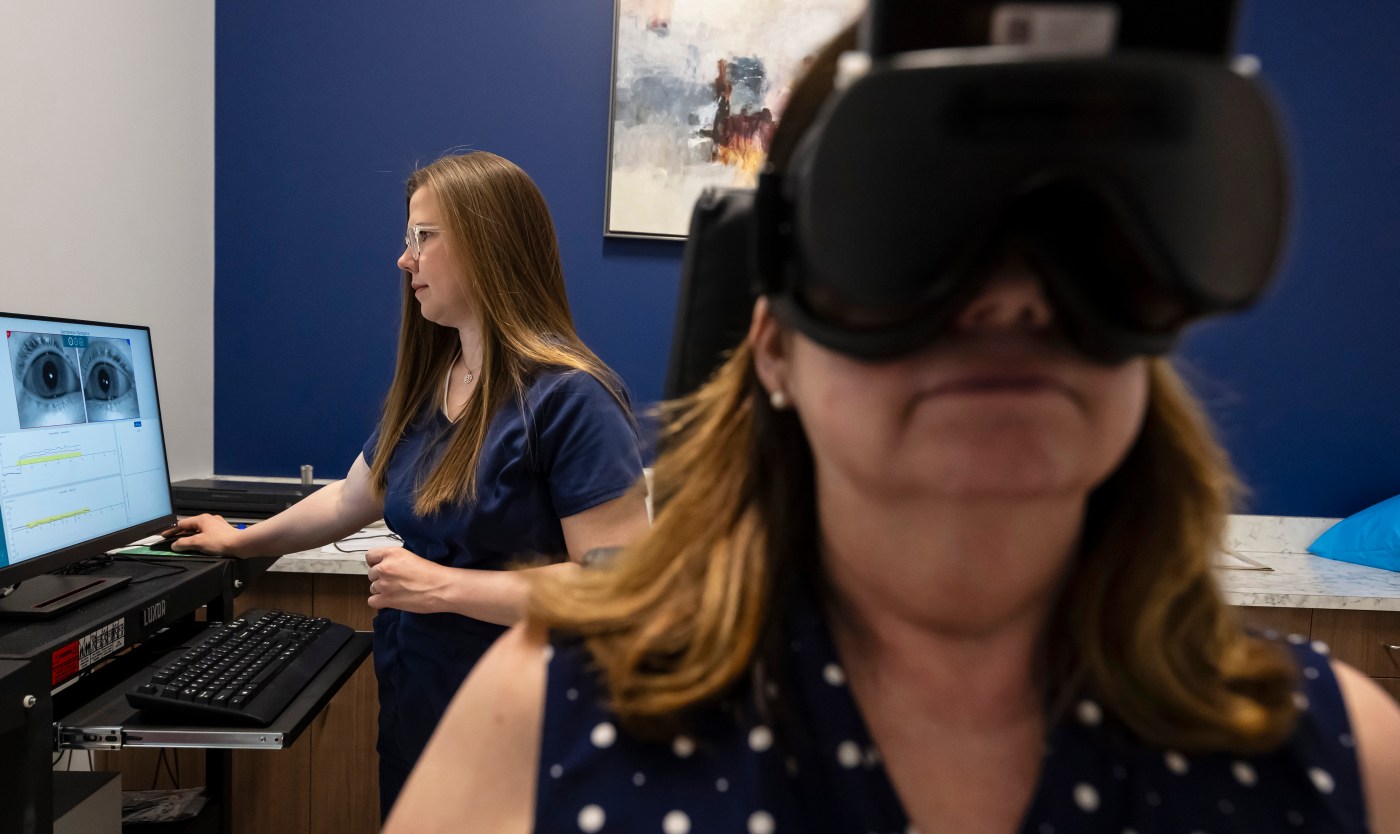
St. Paul audiology specialist finds balance issues are big business
As an audiologist, Rebecca Younk holds a doctorate in the sensitive workings of the ear, making her 11 clinics and offices across Minnesota important bunkers in the war on hearing loss. Increasingly, her St. Paul headquarters also is providing a foothold in a burgeoning, lesser-known battle against falling down.
Americans are tumbling more — an unusual epidemic that, for obvious reasons, hits the elderly especially hard. Researchers have attempted to pin blame on everything from digital distractions like smartphones to footwear, obesity and the side effects of certain medications. Diabetes, for instance, can cause neuropathy, or a loss of feeling in the nerves, especially in the feet and legs. That’s a dangerous burden for a rapidly aging population.
“The science of balance is new and evolving,” said Younk, who for the past 10 years has run Associated Hearing Care, which is still better known for adjusting hearing aids than for addressing dizziness or vertigo. “Balance is often controlled in the ear. Our balance organ is the same structure as the hearing organ. (But) there is no one reason someone falls.”
Younk last year relocated her company’s 50-year-old St. Paul headquarters from the Central Medical/Ries Tower on Dunlap Street to 2550 W. University Ave. for more space. At the time, she decided to hire an inner-ear specialist — vestibular audiologist Samantha Rossmann, or “Dr. Samantha” — to focus in part on patients with balance issues, a growing part of Younk’s practice.
“My goal is to have it become 100% of her work,” said Younk, who provides visiting services each week in rural hospital systems in Morris, Montevideo and Glenwood, counties whose populations are aging even faster than the metro.
A spin in a rotary chair
Younk said balance screenings — which are done in St. Paul — now constitute about 10% of her company’s business, up from zero, and investments in new technology at her St. Paul hub have come in handy. Patients can go for a literal spin in the new Orion rotary chair while wearing goggles that track their pupils, with the goal of determining if their balance issues are ear-based or should be referred to a neurologist for further study.
“It helps us determine is there a concern with the peripheral system of our vestibular anatomy — so, the organ itself — or is someone having trouble with the central processing, from the cerebellum to the inner ear,” said Rossmann, who administers the screenings.
An even newer device, an electronic screener or balance board, measures foot movements as the patient tries to balance themselves on an uneven surface with their eyes open, and then closed.
“We get more of an objective test, because the board is identifying where a person’s center of gravity is — Are they leaning backwards more? Are they leaning forwards more? — rather than using our vision and subjectively saying, ‘They were swaying,’” Rossmann said. “We haven’t put it into practice to its full potential yet. We just got it.”
Injuries, fatalities on the rise
It’s all a far cry from hearing aid fittings and the other work more typical of the audiology industry, but Younk said her company’s growing focus on balance challenges isn’t just academic.
People with hearing loss are nearly three times as likely to fall compared to those with normal hearing, according to the National Council on Aging, which has labeled falls the leading cause of both fatal and non-fatal injuries among older adults, a rapidly growing portion of the population.
Younk noted that at least one study in recent months has found falling to be less prevalent among older adults who wear hearing aids, though the sample size of the population tested was small.
“There’s a lot of thoughts on it, but the biggest one is cognitive load — your brain is working so hard in the environment to see and hear, sometimes you forget where you’re walking,” Younk said.
Related Articles
MN Health Department updates fish consumption guidelines for PFAS
Joe Soucheray: Was politics a factor in Mary Moriarty’s charity to Tesla vandal?
Mischief Toy Store of St. Paul joins lawsuit against Trump tariffs
St. Paul shooter gets 19½-year prison sentence for killing man on University Avenue who had his back to him
St. Paul chief finance officer John McCarthy leaves for League of MN Cities
Overall, the death rate from older adult falls has been going up, rising from 55.3 deaths per 100,000 older adults in 2012 to 78 deaths in 2021, according to the National Council. Meanwhile, the population of older adults is also increasing. Roughly 58 million Americans are age 65 or older, and that age group is projected to rise to 88.8 million by 2060.
As it stands, one out of four older adults falls each year, and 3 million adults over the age of 65 are treated in emergency departments for unintentional falls. That equates to an older adult arriving in an emergency room because of fall-related injuries every 11 seconds and dying every 19 minutes.
Those falls come at a cost to the nation of $50 billion per year, according to the National Council.
Initial screenings
A growing number of experts — including the American Speech-Language-Hearing Association (ASHA) — now recommend that patients suffering from dizziness or vertigo see an audiologist for their initial screening, rather than an ear-nose-and-throat surgeon.
In recent decades, new audiologists have been required to get their doctorate in the science, but they’re still more affordable to access than surgeons and physicians in a medical field increasingly overloaded with patients.
Related Articles
MN Health Department updates fish consumption guidelines for PFAS
A 6-hour morning routine? First, try a few simple habits to start your day
Whooping cough cases are rising again in the US, challenging public health departments
Worries about flying seem to be taking off. Here’s how to cope with in-flight anxiety
Measles misinformation is on the rise — and Americans are hearing it, survey finds
With demand for her services growing, Younk recently hired her husband as a business manager, continuing a decades-old tradition of keeping Associated Hearing Care a family-driven business.
The company, which was launched in February 1975 by the late Ron J. Perlt, is celebrating its 50th anniversary this year and still employs one of Perlt’s daughters as a hearing aid specialist.


